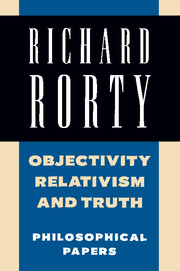Book contents
- Frontmatter
- Contents
- Acknowledgments
- Introduction: Antirepresentationalism, ethnocentrism, and liberalism
- Part I
- Solidarity or objectivity?
- Science as solidarity
- Is natural science a natural kind?
- Pragmatism without method
- Texts and lumps
- Inquiry as recontextualization: An anti-dualist account of interpretation
- Part II
- PART III
- Index of names
Inquiry as recontextualization: An anti-dualist account of interpretation
Published online by Cambridge University Press: 05 June 2012
- Frontmatter
- Contents
- Acknowledgments
- Introduction: Antirepresentationalism, ethnocentrism, and liberalism
- Part I
- Solidarity or objectivity?
- Science as solidarity
- Is natural science a natural kind?
- Pragmatism without method
- Texts and lumps
- Inquiry as recontextualization: An anti-dualist account of interpretation
- Part II
- PART III
- Index of names
Summary
Think of human minds as webs of beliefs and desires, of sentential attitudes – webs which continually reweave themselves so as to accommodate new sentential attitudes. Do not ask where the new beliefs and desires come from. Forget, for the moment, about the external world, as well as about that dubious interface between self and world called “perceptual experience.” Just assume that new ones keep popping up, and that some of them put strains on old beliefs and desires. We call some of these strains “contradictions” and others “tensions.” We alleviate both by various techniques. For example, we may simply drop an old belief or desire. Or we may create a whole host of new beliefs and desires in order to encapsulate the disturbing intruder, reducing the strain which the old beliefs and desires put on it and which it puts on them. Or we may just unstitch, and thus erase, a whole range of beliefs and desires – we may stop having attitudes toward sentences which use a certain word (the word “God,” or “phlogiston,” for example).
By a familiar trick, you can treat desires as if they were beliefs. You do this by treating the imperative attitude toward the sentence S “Would that it were the case that S!” as the indicative attitude “It would be better that S should be the case than that not-S should be.”
- Type
- Chapter
- Information
- Objectivity, Relativism, and TruthPhilosophical Papers, pp. 93 - 110Publisher: Cambridge University PressPrint publication year: 1990
- 3
- Cited by



